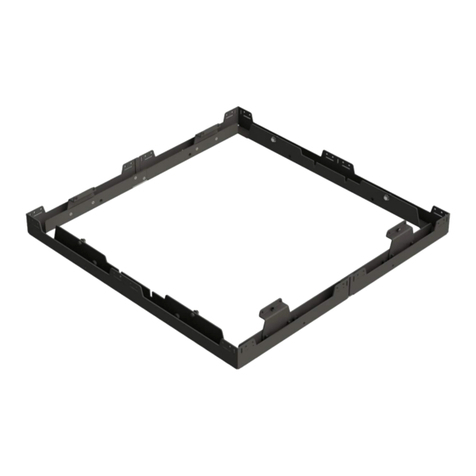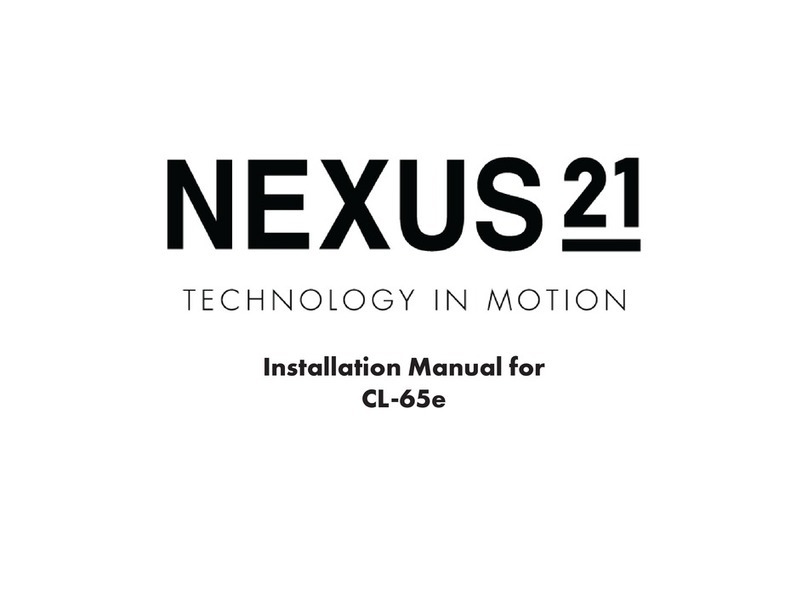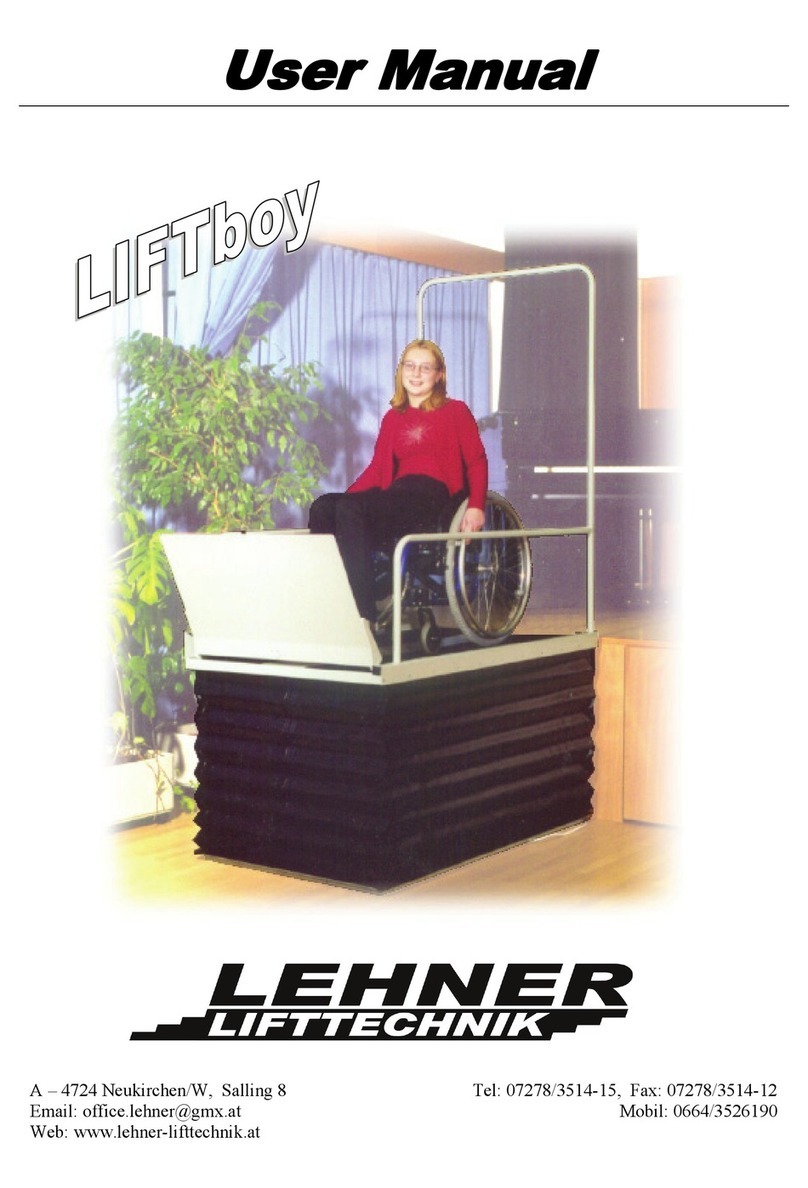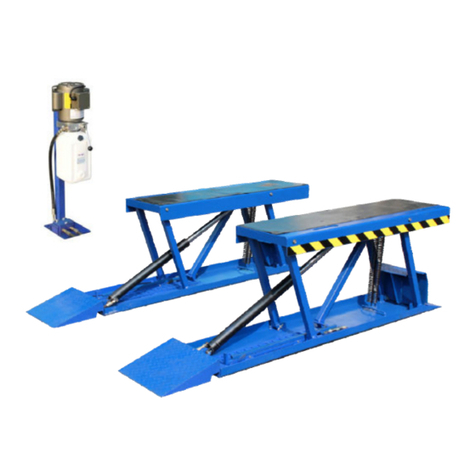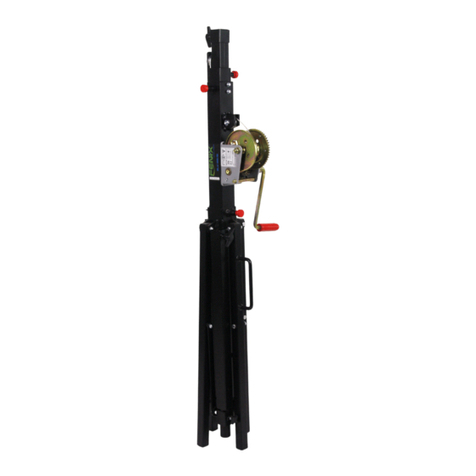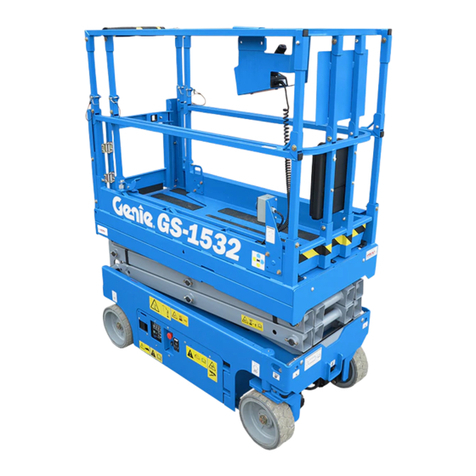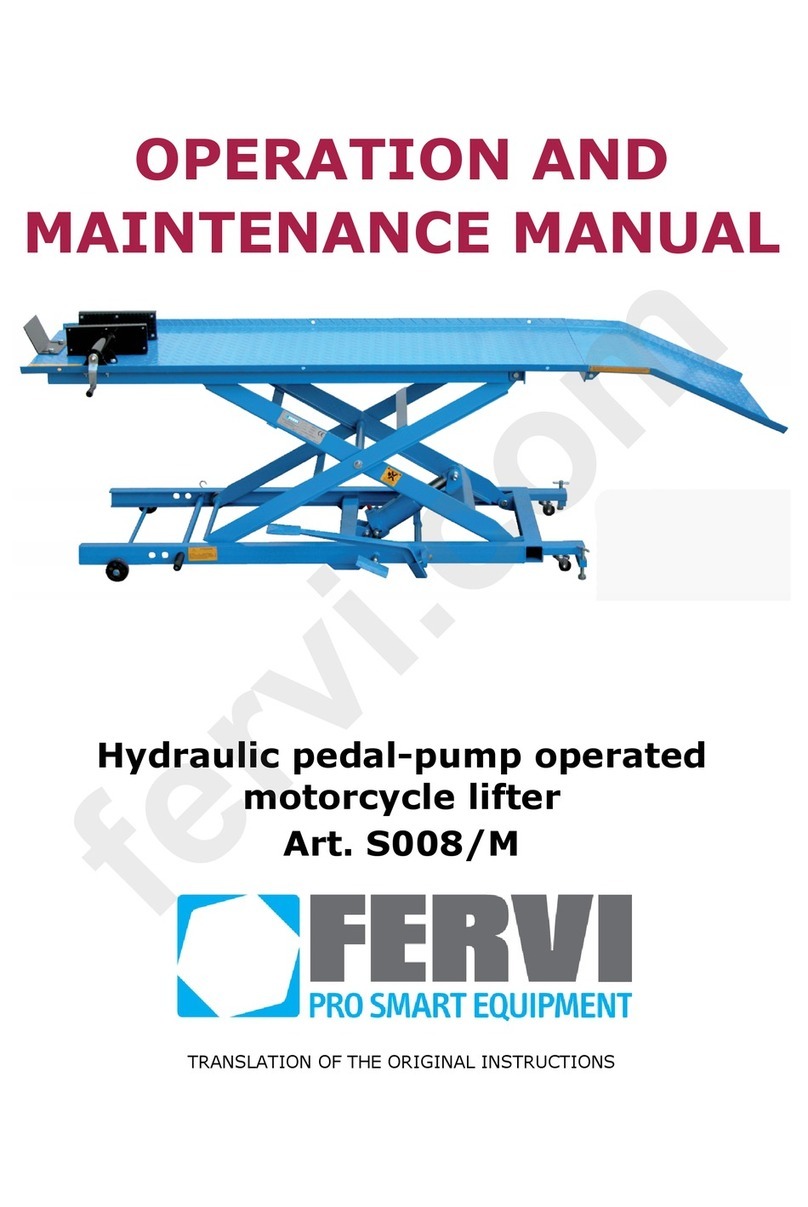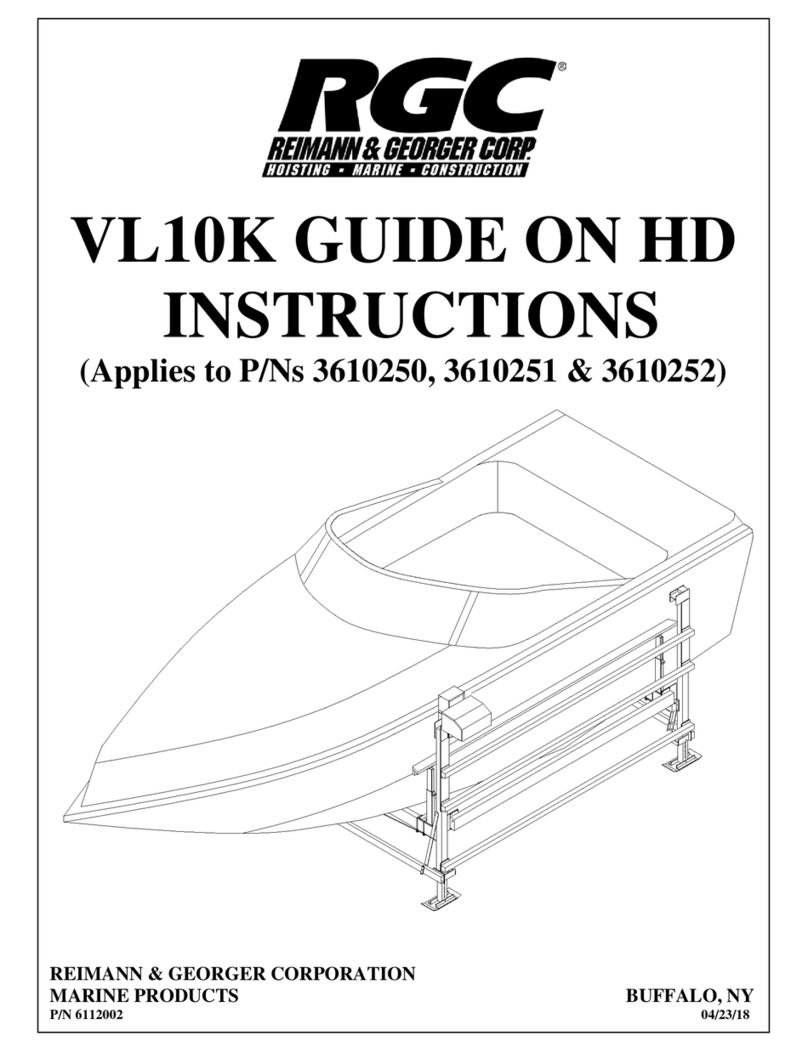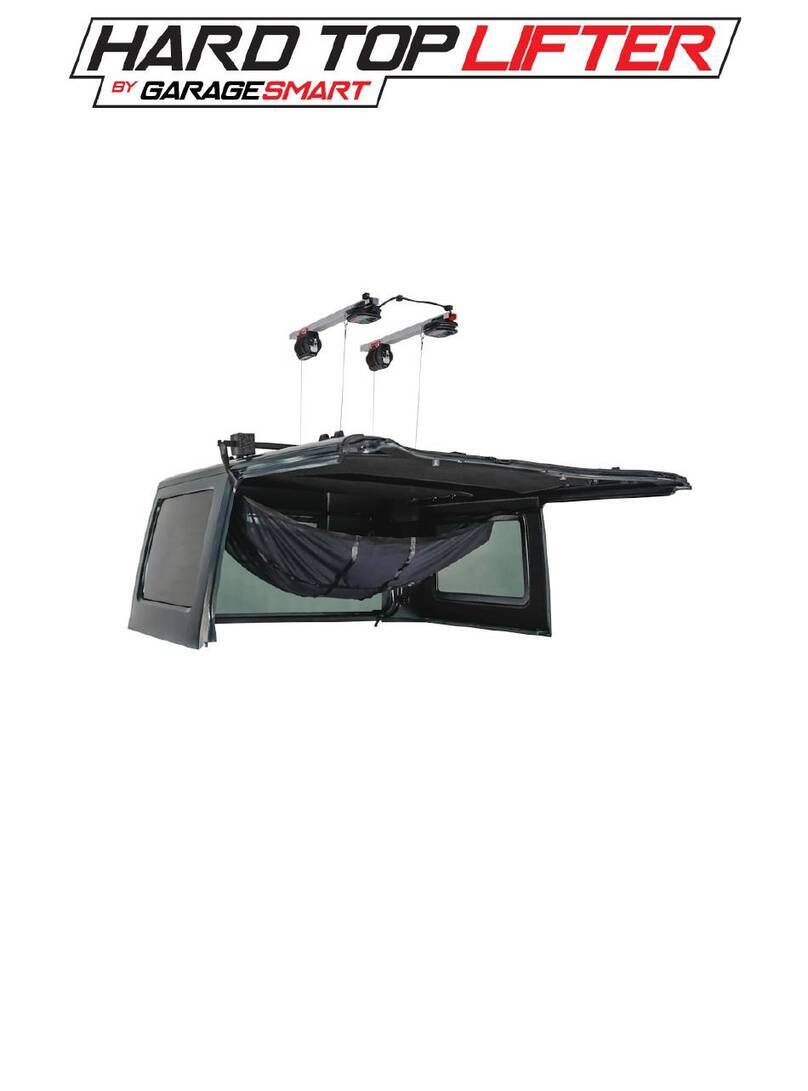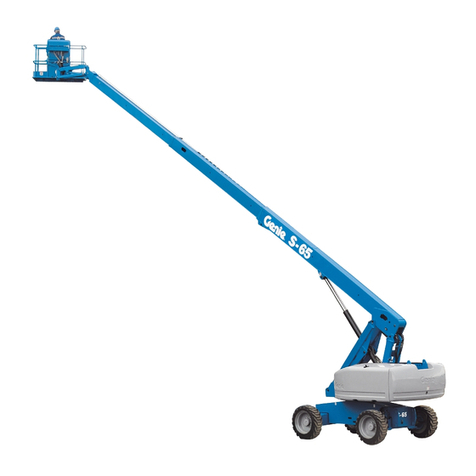Nexus 21 DL-45b User manual

TV Lift System Model DL-45b
Installation Instructions

2

3
Contact: Sup[email protected]
Toll Free: (866) 500-5438
Phone: (480) 951-6885
Fax: (480) 951-6879
Revision: 6/07/16
Below is a parts list describing all of the items included with the Model DL-45b Lift System. You may
also wish to refer to the diagram shown on “Supplemental Page A” (at the end of this document).
Before beginning assembly and installation, please make sure that you have all items included on the
list. If any parts are missing or damaged, please contact Nexus 21. Our contact information is shown
at the top of this page.
Parts List
1. Lift Column (2) 2. Vertical Mounting Bars (4) 3. Screen Back Plate (2)
(20” x 1”) (32” x 9”)
4. Foot Plate (4) 5. Screen Support (2) 6. Control Box
(1 ½”x 6 ½”)(6.4 ”x 15.7”) (10 ½” x 3 ¾” x 1 ½”)
7. Top Plate (2) 8. Top Support Brackets (4) 9. Assorted TV Mounting Screws (2)
(18” x 4 ½- 6 ½”) (14” x 2 ¾”)(6 ½” x 4”)
NOTE: Items 2 & 3 are included in the “Nexus 21 Standard TV Mount” package.

4
Parts List, continued
Cables
Motor Cable –Black cable with white, six-pin plugs. Use this cable to connect the Lift Column to the
Control Box (using slot #1 & #2 on the Control Box). Three feet long.
Power Cable –Connects Control Box to power outlet. Three feet long.
RF Cable (only present if you ordered the RF version of the Lift System) –Use to connect the RF
Receiver to the Control Box. Ends have telephone-style connectors. One foot long.
Hardware
10. Four (4) -- Screen Locks (In bag labeled PDM-0108 - Located in box with Part #2 and #3)
11. Eight (8) -- 6mm x 12mm Flat Head Machine Screw
12. Twenty-Eight (28) -- 6mm x 12mm Button Head Machine Screw (4 Leftover)
13. Four (4) -- 1½” x ¼” Steel Threaded Taper Pins (For Floating Top)
14. Sixteen (16) -- 3/8 - 16 x ¾” Button Head Machine Screw
15. Eight (8) -- 6mm x 16mm Button Head Machine Screw
16. Two (2) -- #10 x 1 ¾” Flat Head Wood Screw
17. Forty-Four (44) -- #10 x ¾” Truss Head Wood Screw ( 12 Leftover)
18. Four (4) -- #8 x ¾” Flat Head Wood Screw (For IR controls only)
19. RF Controls or IR Controls (see explanation on page 6)
20. Two (2) -- Allen Wrenches 4mm and 7/32”
21. One (1) -- “Snakeskin” Wire Management Sleeve
22. Four (4) -- Velcro end Ties, for use with Wire Management Snakeskin
23.Four (4) -- Plastic Ties, also for use with Wire Management Snakeskin
24.Four (4) -- Square Multi Mount Washers
25. Four (4) -- Lid Catch Brackets w/ (8) #10 x ¾” THWS
Wire Management
The Lift System has no exposed gears or moving parts that can
damage your wires, so wire management is simple. We have
included a 48” SNAKESKIN sleeve, which is a state-of-the-art wire
bundling and protection system (the sleeve can be cut shorter if
you wish). The System also includes 4 Velcro end ties and 4
plastic ties. Use the Velcro ties at the ends of the SNAKESKIN, to
close the ends of the sleeve and to keep the wires together inside
it. Use the plastic ties to fasten the cable bundle in a fixed
position, so it moves up and down with the lift.

5

6
SAFETY INFORMATION
SEVERE PERSONAL INJURY AND PROPERTY DAMAGE CAN RESULT FROM IMPROPER INSTALLATION
OR ASSEMBLY. READ THE FOLLOWING WARNINGS BEFORE BEGINNING:
WARNINGS:
1. Do not use this product for any application other than those specified by Nexus 21.
2. Do not exceed the weight capacity. This can result in serious personal injury or damage to the equipment. It is the installer’s
responsibility to ensure that the total combined weight of all attached components does not exceed that of the maximum
figure stated.
3. Follow all technical specifications and instructions during the installation.
4. Only use attachments/accessories specified by the manufacturer.
5. Close supervision is necessary when this system is being used by, or near, children, or disabled persons.
6. It is the responsibility of the installer to warn all potential users of the dangers of interfering with the mechanism during
operation.
7. Read all technical instructions fully before installation and use. It is the installer’s responsibility to ensure that all
documentation is passed on the users and read fully before operation.
8. Failure to provide adequate structural strengthening, prior to installation can result in serious personal injury or damage to
the equipment. It is the installer’s responsibility to ensure the structure to which the Lift System is affixed can support four
times the weight of the system.
9. Risk of electric shock. Do not attempt to open the Control Box.
10. To reduce risk of fire or electric shock, do not expose parts to rain or other liquids.
11. Protect the power cord from being walked on or pinched.
12. Keep all documentation.
13. Heed all warnings.
14. Clean only with a dry cloth.
15. Refer all service questions to Nexus 21 if the system does not operate normally.
Nexus 21 disclaims any liability for modifications, improper installations, or installations over the specified weight range. Nexus 21 will not be liable for
any damages arising out of the use of, or inability to use, Nexus 21 products. Nexus 21 bears no responsibility for incidental or consequential damages.
This includes, but is not limited to, any labor charges for the servicing of Nexus 21 products performed by anyone other than Nexus 21.
Nexus 21 intends to make this and all documentation as accurate as possible. However, Nexus 21 makes no claim that the information contained herein
covers all details, conditions or variations, nor does it provide for every possible contingency in connection with the installation or use of this product. The
information contained in this document is subject to change without prior notice or obligation of any kind. Nexus 21 makes no representation of
warranty, expressed or implied, regarding the information contained herein. Nexus 21 assumes no responsibility for accuracy, completeness or
sufficiency of the information contained in this document.
CABINET LID HAZARD
TV HAZARD
CAUTION: Avoid contact with the TV and Lift System during
operation. Use with caution.
CAUTION: The cabinet lid must be installed as described in the
instructions, using the Steel Threaded Tapered Pins. Installing
the cabinet lid in any other fashion will create hazardous pinch
points that can cause serious personal injury.

7
Types of Controls for Nexus 21 Lift Systems
All Nexus 21 Lift Systems come standard with a wireless remote control and receiver. We offer a choice of two different
type of remotes: IR and RF (both of which are explained in detail below). Our standard control type is RF, so unless you
specifically requested the IR version when you made your purchase, you probably received the RF controls with this Lift
System. The method of installation for each type of remote control is slightly different, so you should now identify which
type of remote you have by reading below, and then follow the instructions for that type of remote.
NOTE: If you will be using the Lift with a home control system (like the ones made by companies such as Crestron or
Control 4) the most common form of control is to WIRE IT DIRECTLY to the relays of your home control system. This
direct-wire method is called Integration by Contact Closure, and is accomplished by using the Backup Control Switch
(Height Limit Switch) that was supplied with the Lift System to connect the Lift to the control unit from your home control
system.
Before You Begin the Installation: Identify Your Control Type
IR (Infrared) –This control option allows you to utilize a 3rd party universal style remote control to raise and lower the
TV Lift. Your universal remote will “learn” the IR codes from the provided IR Handset, which will enable you to control the
lift. The universal remote will then communicate with the “eye” located on the IR Receiver via your 3rd party emitter (or
flasher). Instructions for mounting the IR controls are on page 13. Instructions for setting the TV Lift’s travel limit are on
Supplemental Page B.
NOTE: If you are NOT planning on using a 3rd party Universal Remote, switch to the RF setup. (There is no charge for swapping)
These are the parts included with IR controls:
Contact Closure Hardware IR Receiver IR Handset Height Limit Insert
RF (Radio Frequency) - This system utilizes a wireless remote control handset that sends a radio signal to the RF
Receiver. The radio signal can go through cabinet walls and does not require line-of-sight. Instructions for mounting the
RF controls are on page 14. Instructions for setting the Lift System travel limit are on Supplemental Page B.
TIP: Planning to integrate the TV Lift with your UNIVERSAL REMOTE CONTROL? The RF version of the Nexus 21 controls won’t do
it. Switch to IR.
These are the parts included with RF controls:
Backup Switch RF Receiver RF Handset Height Limit Insert
Integration by Contact Closure –To direct-wire the TV Lift controls to a home control system (Crestron, Control 4,
AMX, etc.) you will use the Back-up Control Switch (Height Limit Switch). You won’t use any Nexus 21 receiver or handset
for this type of control because you will use the handset or control pad that comes with your home control system.
Instructions for setting up the System using Contact Closure are on “Supplemental Page C”.

8
Assembly and Mounting –Things to Think About First
SAFETY NOTICE:
For proper support, the Lift System MUST NOT be attached to any material that is less than ¾”
thick. This applies to BOTH the back and bottom mounting points.
The Lift Column is ONLY designed and rated for VERTICAL, NON-INVERTED USE. DO NOT
MOUNT THIS LIFT SYSTEM UPSIDE DOWN or SIDEWAYS (HORIZONTALLY, AS IN A LATERAL MOUNT)!
TIP: Inverted (drop down) lift systems are available from Nexus 21. Contact Customer Service at
(866) 500-5438.
Space requirements for the DL-45B Lift System are as follows:
Depth = TV Depth x 2 + 10”, or 16”minimum.
Height = TV Height + 2.5”, or a minimum of 29.5”, whichever is greater.
Width = TV Width + 2”, or 43.5” whichever is greater.
IMPORTANT NOTE: The TV must be mounted as high up as possible inside the cabinet, so that when
the Lift is in the fully “DOWN” position (fully retracted), the top of the TV will be just underneath the
lid of the cabinet.
Lift System height and mounting position:
The Top Support Brackets (Part #8) allow you to adjust the installation height of the Lift up to 8” (in ½”
increments) to fit your cabinet height. When fully assembled, the height of the Lift will be a minimum of 29.5”
and a maximum of 37.5”with the Top Support Brackets in the highest position. If the inside height of your
cabinet is taller than this, you will need to mount the lift higher up inside the cabinet.
About the Cabinet Lid (Cabinet Top)
SAFETY NOTICE -- REFER TO PAGE 4:
WARNING! YOU MUST NOT DIRECTLY SCREW THE CABINET LID (TOP) TO THE LIFT SYSTEM!!
THIS CREATES HAZARDOUS “PINCH POINTS” AND MAY AFFECT THE OPERATION OF THE LIFT OR
CAUSE DAMAGE TO THE CABINET TOP.
For floating lids, DO NOT USE SCREWS to attach the lid to the Lift System. Instead, use the
“Threaded Taper Pins”. This will keep the lid firmly in place, but will also allow it to separate from the
lift system if anything (like a finger) gets in the way when the TV lowers.
Which Lid Style Will You Use? (There are 2 Different Styles) –Hinged Lid Not Compatible
Floating Lid (Floating Top) –The whole top of the cabinet sits on top of the Lift System and raises/lowers with
the TV. This is the standard Installation method, using the Top Plate (part #8) and Threaded Taper Pins.
Cut-Out Floating Lid (Top) –You will “cut out” part of your cabinet top, customizing it to the size of your TV.
That cut-out lid then sits on top of the Lift System and raises/lowers with the TV. This method uses the Top
Plate (part #8) and Threaded Taper Pins, but you must set up a “catch” for the cut-out lid so that when the TV
lowers, the lid stops level with the rest of your cabinet top (like a manhole cover).
NOTE: There are several different methods for setting up the “catch”, but the hardware
to do it is not included with the Lift System because it is part of the cabinet. Hardware
suggestions include: buy 4 small corner brackets and screw to underside of main top, with
edges exposed to catch the corners of the cut-out lid. The same thing can be accomplished
with 1” x 1” “cleats”, which are strips of hardwood, mounted underneath, with edges
exposed to catch the lid.

9
You Are Ready to Begin
Step 1: Inventory the Parts List. Carefully inspect all items, making sure you have everything in the Parts List
on page 1. Be sure to open the Nexus 21 TV Mount carton that includes parts #5 and #6.
Step 2: Attach four Foot Plates to both Lift Columns. Using the small allen wrench provided, attach two Foot
Plates to each lift column using eight (8) 6mm x 16mm BHMS, four (4) per lift column.
Step 2a: Step 2c:
Step 2b:
Step 3b:
Step 3: Attach both Screen Support Brackets to the top
of the Lift Columns. Slide one (1) Screen Support Bracket
down on top of each lift column. Using eight (8) 6mm x
16mm BHMS Screws (four screws per Screen Support)
fasten each Screen Support to the top of each lift column.
Step 3a:

10
Step 4: Attach the Top Support Brackets to the Screen Support Brackets. Measure the interior height of the
cabinet, from the base of the cabinet to the bottom side of the lid opening. Use this measurement to figure
out exactly what set of holes to use when attaching the Top Support Brackets. The Top Support Brackets
should sit ½” – ¾” below where the lid will rest when collapsed. Using Sixteen (16) 6mm x 12mm BHMS
Screws (four screws per Top Support Bracket) fasten one Top Support Bracket to each of side of both Screen
Support Brackets.
Step 4a: Step 4b:
Step 5: Attach a Top Plate to each set of Top Support Step5b
Brackets. Using eight (8) 6mm x 12mm FHMS Screws
(four screws per Top Plate) fasten one Top Plate to
each set of Top Support Brackets.
Step 5a:

11
Step 6: Attach the Screen Back Plates to the Screen Support Brackets. Using sixteen (16) 3/8” x 16mm BHMS
Screws (eight screws per Screen Back Plate) fasten the Screen Back Plates to both of the Screen Support
Brackets. Make sure to rotate one lift column, so both lift columns face the opposite direction before you
attach the plates. You will want to install each Screen Back Plate so it’s centered, or slightly higher than the
center, on the back of the TV after the TV is mounted.
Step 6a: Step 6b:
Step 6c: Step 6d:
Step 7: Position the Lift Columns in the cabinet. Make Step 7b:
sure they are centered from left to right and front to back
within your cabinet opening. You may need to twist the
lift columns while they rest in the cabinet in order to
square the Foot Plate with the cabinet.
Step 7a:

12
Step 8: Mount the Foot Plates to the base of the
cabinet. Using Twelve (12) #10 x ¾” THWS Screws
(six screws per Foot Plate) fasten both Foot Plates to
the base of the cabinet.
NOTE: You may need to twist or rotate the lift columns
in order to square the Foot Plates with the cabinet walls.
Step 9: Mount the Control Box and controls to the wall at a nearby accessible location: Using (4) #10 x ¾”
FHWS mount the Control Box to the wall. Using (2) #8 x ¾” FHWS mount the Wired Back Up Switch. If you
ordered IR Controls, then you will use (2) #8 x ¾” FHWS to mount the IR Receiver. If you ordered RF Controls,
then you will use (2) #6 x ¾” FHWS to mount the RF Receiver.
RF Controls: IR Controls:
Step 10: Connect the cables for the IR Controls & Control Box as noted on the diagram on the following
page, or on page 14 for the RF Controls & Control Box.

13
IF YOU HAVE IR CONTROLS, USE THIS DIAGRAM (for RF Controls, see the following page)
Once you have connected the controls, test the Lift Column as follows:
First, you need to “initialize” the Lift System. If you have already raised the Lift Column, lower it again, since this step must be
performed in the “down” position. Find the Wired Backup Switch, which has two triangle-shaped buttons - an UP (with raised dot) and
a DOWN. Press the DOWN button and HOLD IT DOWN for approximately 5 seconds. You should see a slight movement in the Lift
Column. If you do not see the movement, release the Down button, and repeat the process - press and hold the Down button again for
5 seconds. Once you have seen the slight movement, the Lift System is now functional. Test it by pressing the Up button (no need to
hold the Up button) and the lift will go up. You may let it go to the top, or stop it at any time by pressing the Down button.
DL-45b Wiring Diagram
with IR Controls

14
IF YOU HAVE RF CONTROLS, USE THIS DIAGRAM (for IR Controls, see the previous page)
Once you have connected the controls, test the Lift Column as follows:
First, you need to “initialize” the Lift System. If you have already raised the Lift Column, lower it again, since this step must be
performed in the “down” position. Find the Wired Backup Switch, which has two triangle-shaped buttons - an UP (with raised dot) and
a DOWN. Press the DOWN button and HOLD IT DOWN for approximately 5 seconds. You should see a slight movement in the Lift
Column. If you do not see the movement, release the Down button, and repeat the process - press and hold the Down button again for
5 seconds. Once you have seen the slight movement, the Lift System is now functional. Test it by pressing the Up button (no need to
hold the Up button) and the lift will go up. You may let it go to the top, or stop it at any time by pressing the Down button.
DL-45b Wiring Diagram
with RF Controls

15
Installing the Tapered Pins in the Floating Lid
What Are the Tapered Pins, and Why Use Them?
The two 1½” x ¼” Steel Threaded Tapered Pins are used IN PLACE OF SCREWS to hold your cabinet top (lid) in
place on the Lift System Top Plate (Part #8). The Tapered Pins will keep your lid firmly in place, but will also
allow it to separate from the lift system if anything (like a finger) gets in the way when the TV lowers. See
Safety Notice above. Please do NOT use screws with your cabinet lid.
Before You Install the Tapered Pins, Here is a Reminder of the Two Types of Floating Lids (Floating Tops):
Floating Lid (Floating Top) –The whole top of the cabinet sits on top of the Lift System and raises/lowers with
the TV.
Cut-Out Floating Lid (Top) –This option assumes that you have “cut out” part of your cabinet top, customizing
it to the size of your TV. That cut-out lid then sits on the Top Plate of the Lift System, held in place by the Taper
Pins, and raises/lowers with the TV. You must set up a “catch” for the Cut-Out Lid so that when the TV lowers,
the Lid stops level with the rest of your cabinet top (like a manhole cover), and the Lift System continues down
a little further into the cabinet (no more than ¼” to ½”). In this way, when the Lift System is fully retracted, the
Cut-Out Lid will always be level, and the Top Plate of the Lift System will always be positioned just below the
Lid. Since the Lid and the Top Plate are slightly separated from one another, but still very close, the Taper Pins
(which are 1½” long) will still be hanging down through the holes in the Top Plate so when the Lift System
moves, everything is properly aligned and the Lid rides smoothly up and down.

16
Tapered Pins
How to Install the Tapered Pins:
You will be screwing the Tapered Pins into the UNDERSIDE of your cabinet lid, and they will hang down and
drop into the two holes in the Top Plate (Part #7).
Step 11: Before installing the Tapered Pins, position the Cabinet Lid. With the Lift System in the fully DOWN
position, make sure the Top Plate is within ½” from the bottom side of the lid. Place the Lid on the cabinet and
move it around on the Top Plate, making sure it fits centered in the cabinet opening.
Step 12:
Step 12: Run the Lift System up and down with the
Cabinet Lid sitting on top, but not attached. Without
bumping the Cabinet Lid out of place, use the Remote
Control Handset to send the Lift System up and down.
Make sure that when the Lift comes down, the
Cabinet Lid drops into the proper position relative to
your cabinet opening.
NOTE: You may want to temporally tape your lid to
the Top Plates, to prevent the lid from shifting.
Step 13:
Step 13: Mark the spots for the Tapered Pins. Again,
without bumping the Cabinet Lid out of place, run the
Lift System all the way UP, with the Cabinet Lid sitting
on top. Look at the UNDERSIDE of the Top Plate, find
the two holes, and use a felt-tip pen or a pencil to
mark the position of the holes on the underside
surface of the Cabinet Lid.
NOTE: Make sure the nuts on the bottom side of the Top Plate are hand tight and centered before you mark
your lid.
Step 14: Remove Cabinet Lid and drill two holes in the marked positions. Use a 7/32” drill bit to drill two
holes, ½” deep, in the underside of the Cabinet Top where you have marked.
Step 14: Step 15: Using a Phillips head screw
driver (not provided) screw each
Tapered Pin into the holes drilled in
step 16.
Step 15:

17
Step 16: Step 16: Place the Cabinet Lid onto the Lift System.
Align the Tapered Pins with the 2 holes in the Top
Plate and put the Lid on. Tighten the nuts on the
underside of the hole where the Tapered Pins pass
through the Top Plate.
NOTE: You will have a ¼” tolerance (in all directions) for the
placement of the Tapered Pins into your cabinet lid. There are a set
of nuts on the underside of the Top Plate that allow you to adjust
the position of the hole that the Tapered Pins will pass through to
secure the cabinet lid to the Top Plate. If you happen to position
the Tapered Pins a few millimeters off from your intended position,
you can still make adjustments to fit properly.
Step 17: Attach the Vertical Mounting Bars
to the TV. Before you begin, hand thread Step 17:
screws (found in bag labeled “TV Mounting
Screws/Spacers”) into the threaded inserts
on the back of both TV’s to determine the
correct screw diameter (M6 or M8). The
length of the screw required will depend on
whether the TV has a flat/unobstructed or
irregular/obstructed back. Follow diagram
“A” for TV’s with flat/unobstructed back.
Use diagram “B” for TV’s with irregular/
obstructed back. The diagrams can be found
on the following page.
Step 18: Mount the TVs (with the Vertical Mounting Bars attached) to the Screen Back Plates. Each Vertical
Mounting Bar has “hooks” on either end that allow the bars to “hang” on the Screen Back Plate. Lift both TVs
onto the Screen Back Plates. Center both TVs. Be sure that both the upper and lower set of “hooks” fully
engages with the Screen Back Plates.
Step 19a: Insert the Screen Locks into both sets of Vertical Mounting Bars. The Screen Locks will be placed
into the lower “hook” that is just below the Screen Back Plate.
Step 18:
Step 19b: Using a Phillips head screwdriver, tighten both sets of
Screen Lock screws into the underside of the Screen Back Plates. This
will lock your TVs onto the TV Lift. You have now successfully attached
your TVs.
Step 19:
Step 20: Do a final wire
management check. Test
operate the Lift and be sure
that all wires are clear of the
Lift so they do not get “hung
up” when the TV’s are moving
either up or down.
Congratulations your DL-45b
Lift System is now
completed!

18
Mounting the TV to the Lift
Step 33: Mount the TV (with the Vertical Mounting Bars attached) to the Screen Back Plate. Each Vertical Mounting
Bar has “hooks” on either end that allow the bars to “hang” on the Screen Back Plate. Center the TV. Be sure that both
the upper and lower set of “hooks” engages the Screen Back Plate.
Irregular/Obstructed Back
Flat/Unobstructed Back
A
B
Diagram “A” installation procedure:
1) Place the flat screen TV face down on a protected surface.
2) Position the Vertical Mounting Bars equidistant from the bottom and top of the TV, with the slots facing toward the top of
the TV.
3) Using the four (4) Square Multi-Mount washers and the TV mounting screws selected from the bag, attach and tighten the
hardware. DO NOT OVERTIGTHEN HARDWARE. DAMAGE TO TV MAY RESULT.
Diagram “B”installation procedure:
1) Place the flat screen TV face down on a protected surface.
2) Position the Vertical Mounting Bars equidistant from the bottom and top of the TV, with the slots facing toward the top of
the TV.
3) Using the four (4) spacers needed, (4) Square Multi-Mount washers and the TV mounting screws selected from the bag,
attach and tighten the hardware. The hardware will be used in this order (as shown in the diagram above): TV, Spacers,
Vertical Mounting Bars, Square Multi-Mount Washers, TV Mounting Screws.
DO NOT OVERTIGTHEN HARDWARE. DAMAGE TO TV MAY RESULT.

19
Supplemental Page A: Dimensional Diagram

20
Supplemental Page B: Setting a Height Limit
Please follow this procedure if you would like to limit the distance that your TV Lift extends.
To set your Travel Limit with IR Controls:
If you want the lift system to always go to its full extension, do NOT use the Height Limit Insert. Simply leave it unplugged and
the system will always travel to the full extension. To limit the travel, follow the procedure below:
1. Using the IR Receiver, run the lift system to
the ideal height limit position and stop it there.
2. With the lift system stopped, plug the Height
Limit Insert into the available RJ45 port on the
Control Box. This will set the height limit at this
position for both the IR Remote (or 3rd party
universal remote) and the IR Receiver.
3. If the height limit is set at the incorrect
position, remove the Height Limit insert and
repeat the procedure.
To set your Travel Limit with RF Controls:
If you want the lift system to always go to its full extension, do NOT use the Height Limit Insert. Simply leave it unplugged and
the system will always travel to the full extension. To limit the travel, follow the procedure below:
1. Using the Wired Backup Switch, run the lift
system to the ideal height limit position and stop
it there.
2. With the lift system stopped, plug the Height
Limit Insert into the available RJ45 port on the RF
Receiver. This will set the height limit at this
position for both the RF Remote and Backup
Switch.
3. If the height limit is set at the incorrect
osition, remove the Height Limit insert and
repeat the procedure.
Table of contents
Other Nexus 21 Lifting System manuals

Nexus 21
Nexus 21 L-75ix User manual

Nexus 21
Nexus 21 L-90 User manual

Nexus 21
Nexus 21 CL-65 Series User manual

Nexus 21
Nexus 21 XL-85s User manual

Nexus 21
Nexus 21 L-27i User manual

Nexus 21
Nexus 21 AL-125 User manual

Nexus 21
Nexus 21 CL-65e User manual
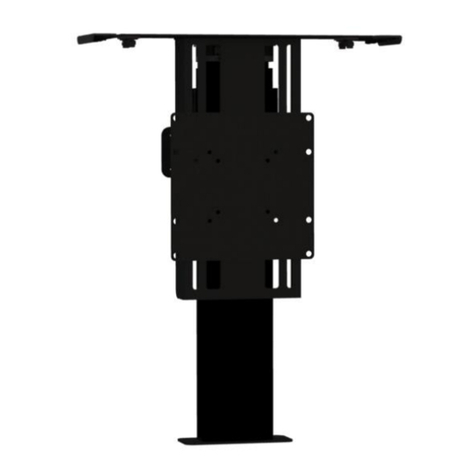
Nexus 21
Nexus 21 L-23S User manual
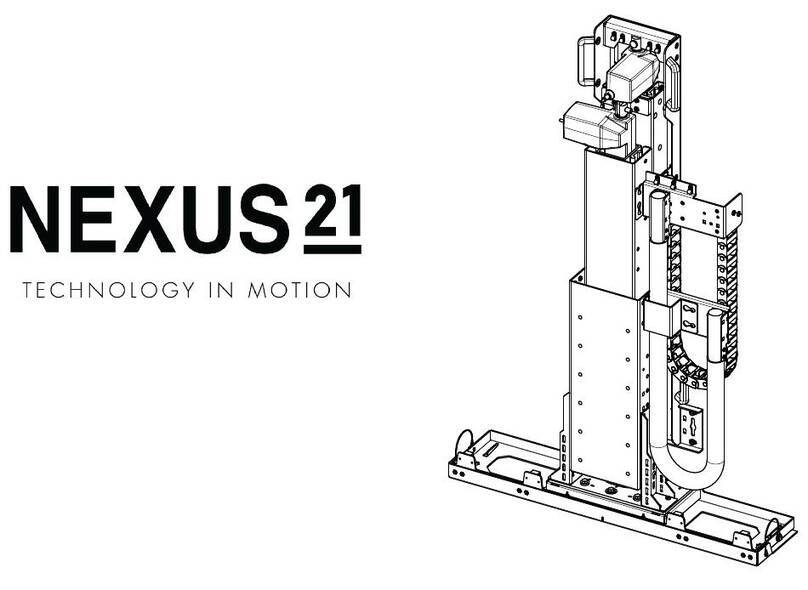
Nexus 21
Nexus 21 L-77i User manual

Nexus 21
Nexus 21 L-85 User manual
Popular Lifting System manuals by other brands

Reechcraft
Reechcraft PowerLift PL20 Operators safety manual
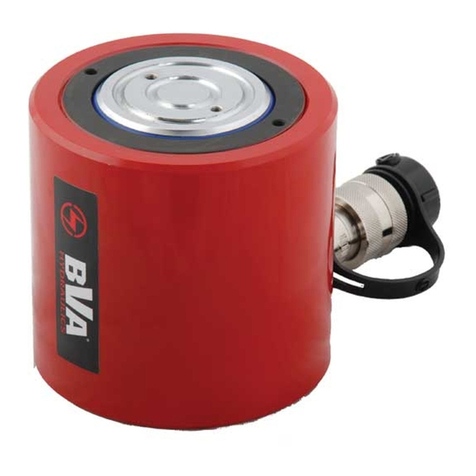
BVA Hydraulics
BVA Hydraulics HL1001 instruction manual

Meyer
Meyer V-71 QUIK LIFT Parts & Installation Instructions

Lift King
Lift King Pro King 9XLT Installation & operation manual
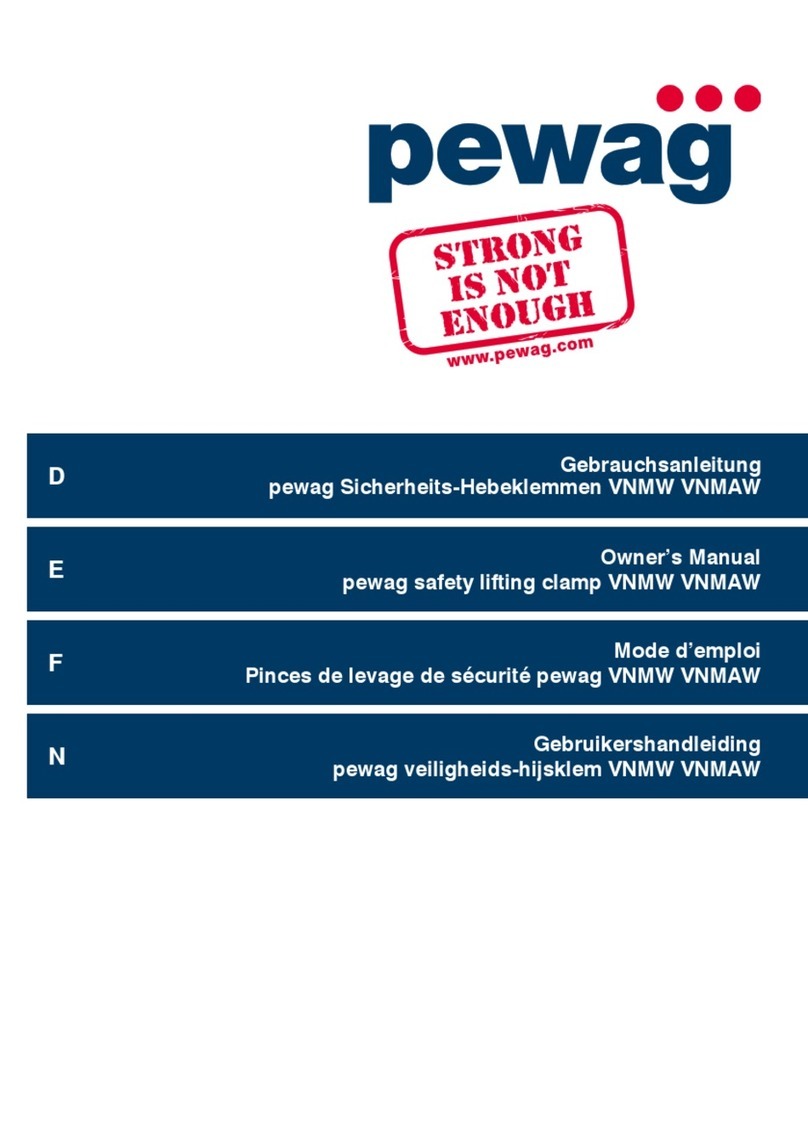
pewag
pewag VNMW owner's manual
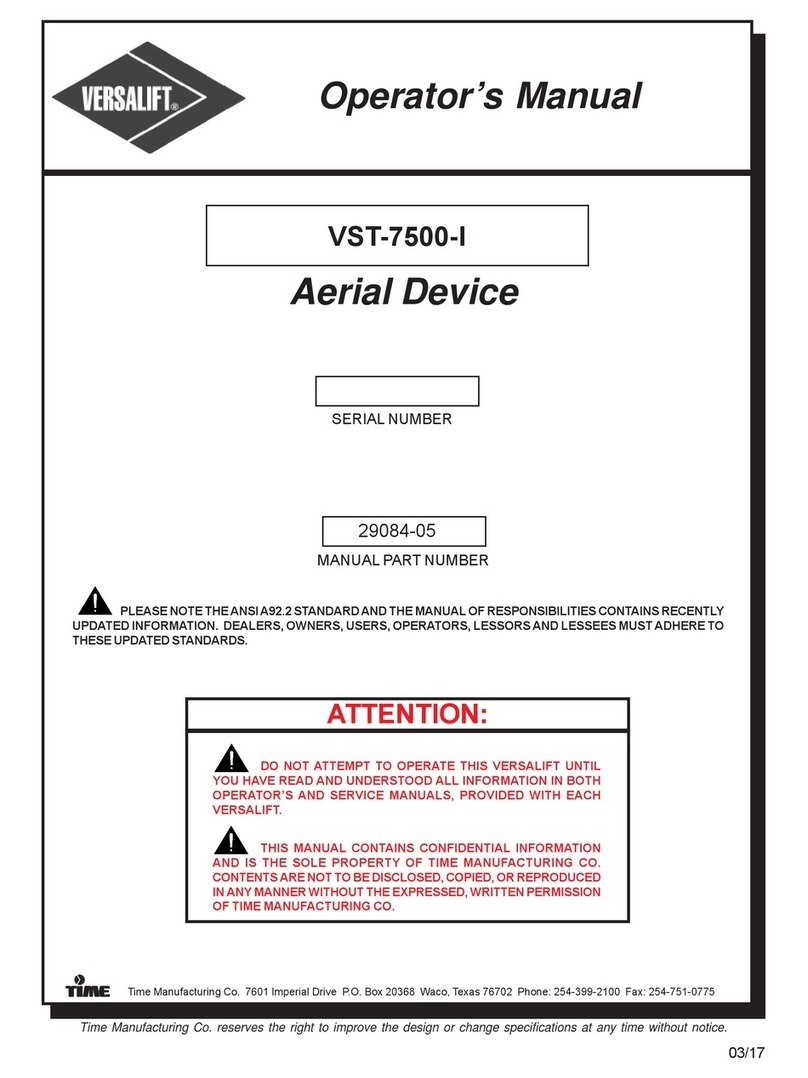
Time
Time VERSALIFT VST-7500-I Operator's manual
